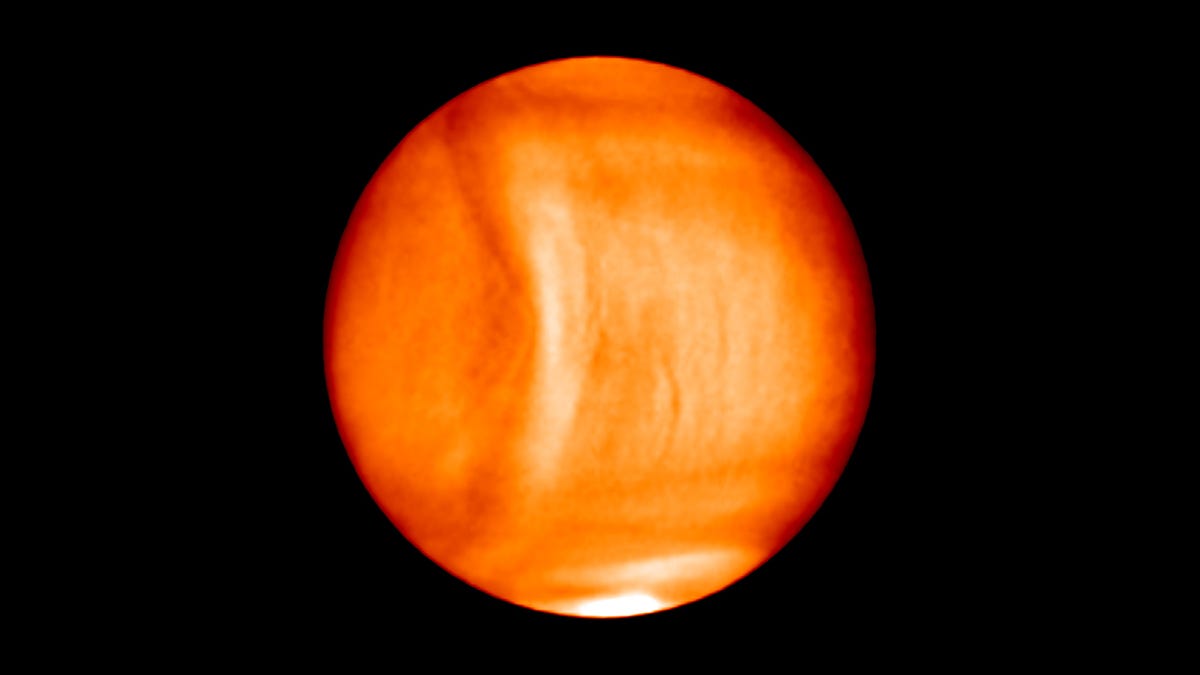Giant gravity wave spotted on Venus
The wave in Venus' atmosphere could be the biggest seen in the solar system.
It looks like a giant ripple across the face of Venus, and that's pretty much what it is. Not long after entering Venusian orbit in December 2015, the Japanese Akatsuki orbiter captured a strange atmospheric phenomenon: a gravity wave in the planet's upper cloud layer.
Don't confuse this with the gravitational waves caused by colliding black holes that made history last year. Gravity waves are common, and you've probably seen their effects on the clouds and oceans with your own eyes. They're caused when an atmosphere or body of water is disturbed, such as tides flowing over a sandbar, or air flowing over a mountain range. As gravity attempts to restore equilibrium, it overshoots, causing a wave effect.
This is what probably caused the 10,000-kilometre (6,214-mile) wave across the surface of Venus. As the atmosphere of thick sulphuric acid cloud rotates at a faster rate than the planet itself, details in the surface topography can cause these disturbances, resulting in large-scale gravity waves.
"Here we report the detection of an interhemispheric bow-shaped structure stretching 10,000 km across at the cloud-top level of Venus in middle infrared and ultraviolet images from the Japanese orbiter Akatsuki," the study, led by Makoto Taguchi of Tokyo's Rikkyo University and published today in the journal Nature Geoscience, reads.
"Over several days of observation, the bow-shaped structure remained relatively fixed in position above the highland on the slowly rotating surface, despite the background atmospheric super rotation. We suggest that the bow-shaped structure is the result of an atmospheric gravity wave generated in the lower atmosphere by mountain topography that then propagated upwards."
Every planet in the solar system has its own peculiarities, but Venus is a straight-up weirdo. Although it's sometimes described as Earth's "twin", being rocky like Earth and of a similar size and mass, it's also wildly different. Its incredibly thick atmosphere is over 96 percent carbon dioxide, which creates an incredible greenhouse effect, and it has a mean surface temperature of 735 Kelvin (462 decrees Celsius, or 863 degrees Fahrenheit). Surface probes sent to Venus have never lasted longer than two hours in the extreme heat, so observations need to be made using orbiters such as Akatsuki.
The wave imaged by Akatsuki is positioned over a continent-sized rugged highland called the Aphrodite Terra. But the surprising thing is that these gravity waves can travel into the upper cloud layers -- and that there seems to be more complex dynamics at play than disturbance caused by the planet's surface topography.
The team plans to make further observations in the next few years as Akatsuki continues its mission in orbit around Venus.
"Numerical simulations provide preliminary support for this interpretation, but the formation and propagation of a mountain gravity wave remain difficult to reconcile with assumed near-surface conditions on Venus. We suggest that winds in the deep atmosphere may be spatially or temporally more variable than previously thought," the study reads.
Batteries Not Included: The CNET team shares experiences that remind us why tech stuff is cool. Take a look here.
CNET Magazine: Check out a sampling of the stories you'll find in CNET's newsstand edition, right here.


